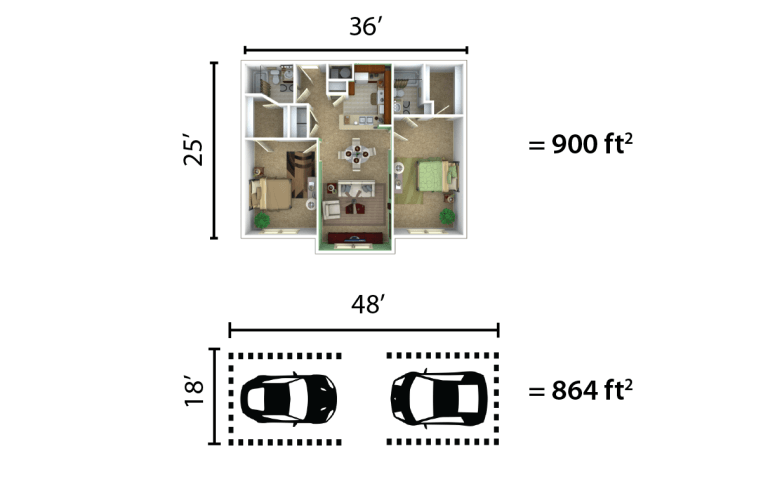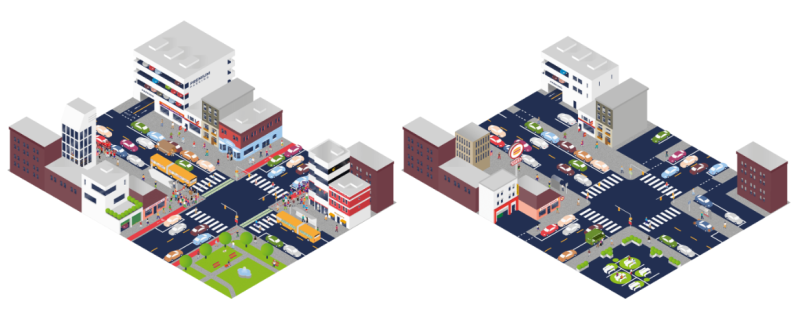Affordable Housing for Cars or for People?
By Alyssa Koehn
Date
July 21, 2017Urban cores have a finite amount of land. Developers have a threshold they desire to reach before they will pursue a project. In a growing affordability crisis, if both land and expenses are set, why do we keep spending these limited resources on housing for cars? Are North American cities ready to change their zoning laws and phase out mandatory parking minimums to support affordable housing?
Parking Demands Driving
Video from Vox. Donald Shoup discusses the effects on cities of “free” parking.
Most cities have many more parking spaces than cars to park in them. In Atlanta, there are currently nine parking spaces available for every one car. The cost of building these spaces is not insignificant. In Donald Shoup’s seminal text on the subject, “The High Cost of Free Parking”, construction costs in a city like Seattle were $35,000 per space in an underground lot and $25,000 per space for each above ground parking space. Even a small project is likely to have hundreds of thousands of project dollars sunk into parking.

Image Credit: PDXShoupistas, Portlanders for Parking Reform
Additionally, the average parking space is about 9 feet wide and 18 feet long, not including the circulation to access these spaces. That’s 162 square feet for every parking space that could be otherwise utilized, or not constructed at all. Parking spaces take up valuable real estate, often on the ground floor. This not only takes space away from additional units, but effects the walkability of the city: parking minimums lead to an urban fabric that requires more driving, while reduced or flexible parking space requirements support walkable urban places.
The argument goes that the easier the access to parking, the more likely people are to drive (a.k.a. the same principles of “induced demand”). If we continue to build housing units with bundled parking, people who live in them will be more likely to drive, as they already have a “free” space. If we remove included parking and charge a separate market rate for it, people will better account for the true costs of parking. If we don’t build parking spaces, people are less likely to drive, freeing up land and resources for housing.

Image Credit: TransitCenter.
Left image shows an urban fabric with minimal parking requirements,
while the right image shows an urban fabric with rigid parking requirements.
Parking Raises Rents
The construction of parking has a direct impact on the cost of rent. In a 2016 study by C.J. Gabbe and Gregory Pierce at UCLA, they found that “the cost of garage parking to renter households is approximately $1,700 per year, or an additional 17% of a housing unit’s rent.” This cost disproportionally impacts low-income families, who most commonly do not own a vehicle, by requiring them to purchase a parking space they may not use.
Not only does less parking mean cheaper construction costs and thus rental costs, but it also means that more lots are able to support housing. Reduced parking minimums help lot and project feasibility, meaning more space can be used for housing units and this space can hold more units per project, increasing the overall supply of housing.
Is North America Ready?
Minneapolis is trying it. While the local development community initially declared that there was no way the market would support such a reduction in units, arguing that a 0.7 parking space minimum would still be required, new buildings are now being constructed with as few as 0.3 spaces per unit. Recently Buffalo bid adieu to its parking minimums all together citywide, opting instead for more holistic considerations of parking in the city.
We’ve also built buildings like this before. The New York Times analyzed the extent of Manhattan’s buildings and found that 40% of them could not be built by today’s zoning codes. Many of these buildings have more units than current zoning would allow, or much less parking than a new building would require. With such pressing housing needs, limited resources, increasing mode shares, and the rise of autonomous vehicle technology, how much longer will we build affordable housing for cars instead of people?








